The course starts on November 26th.General Information The course is offered as an elective component of Master’s programmes in Psychology, Cognitive Science or Language and Linguistics. It can normally be included in a first- or second-cycle degree. Course content The aim of the course is to provide students with practical and theoretical knowledge of how a language corpus is created. The course deals with questions of how to collect, transcribe, code and analyse language data. It also includes exercises in fundamental corpus analysis (e.g. counting the number of words, establishing predetermined search strings, identifying morphological and syntactic patterns, examining lexical measures). Furthermore, the course addresses a selection of texts and ethical aspects of data collection and coding. The emphasis is on spoken language data but other corpus types (written data, sign language) are also considered. The course provides students with a practical and theoretical introduction to different tools for transcribing and analysing the material. Course design The teaching includes lectures and 4-6 compulsory laboratory exercises. Assessment The assessment is based on an oral assignment during the course and a final written assignment. Entry requirements To be admitted to the course, students must have a Bachelor’s degree including 60 credits in Linguistics, a language subject or Cognitive Science, or the equivalent. Further information The course is offered at the Humanities Laboratory, Lund University. The credits allocated for course content that in whole or in part is commensurate with another course can only be credited once for a degree. For further details see the current registration information and other relevant documentation. Interested? Please contact Mats Andrén, mats.andren@semiotik.lu.se
Still vacant places at the course Creating a Language Corpus (HTXN07)!
Published 20 November 2014
To do systematic research on linguistic data, it is necessary to organize the data in ways that match the aims of your research questions. In this course you will learn how to collect, transcribe, analyze and organize linguistic data, to create a language corpus. A large part of the course is spent on learning the practical skills involved in this, such as using software (ELAN and CLAN) for transcription.
